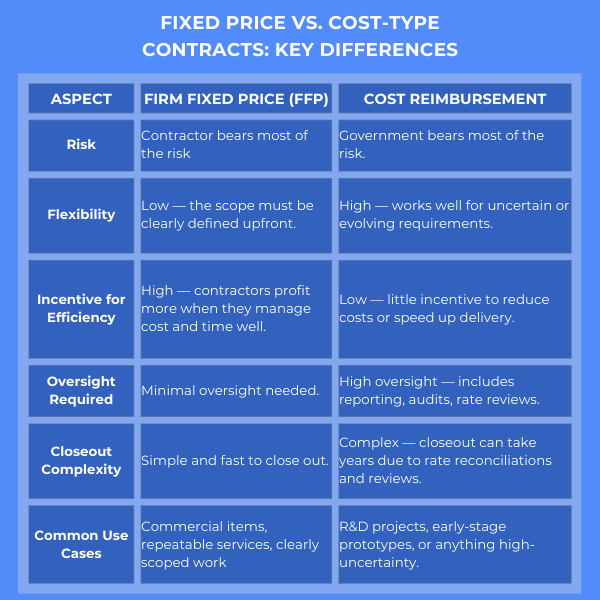Why Contract Type Matters
Do not make the mistake of getting this wrong.
Welcome Future Contractors 👋
The contract type isn’t just another form to fill out. It’s the piece that decides who’s on the hook for risk, how the work gets done, how payment flows—and whether the whole thing holds together or falls apart. Pick the right one, and the job runs smooth. Pick wrong, and even a well-thought-out plan can hit a wall. Let’s unpack why this matters and how to handle it.
If you like this kind of breakdown, hit that subscribe button below. 👇
Fixed Price vs. Cost Reimbursement
Contract types split into two main camps based on who carries the risk. With a Firm Fixed Price (FFP) deal, you agree to deliver something—like a finished product or service—for a set amount. If your costs run over, that’s your problem, not the government’s. Conversely, Cost Reimbursement means the government covers your allowable expenses while you work toward fulfilling the contract objectives, with no challenging total locked in. The government takes on more risk here, and you get some breathing room if expenses shoot up. Think inflation spikes, like what happened during COVID-19.
When does each make sense? FFP fits jobs where the finish line’s clear. Say you’re selling 50 laptops or roofing a building with specs already nailed down—everyone knows what’s expected, so a fixed price keeps it simple. Cost-type deals are better when things are hazy. Think research projects or early prototypes where the needs might shift as you go. For example, I’ve seen a contractor lock in an FFP deal to deliver a software tool, only to find the client’s requirements changed halfway through. They ate the extra cost. A cost-type setup would’ve let them bill those adjustments instead.
Example: You’re buying a commercial software license at a fixed price. You’re funding a research prototype with evolving requirements — cost reimbursement.
How It Plays Out
That choice isn’t just theory—it changes the daily job. With FFP, you’re the one under pressure. Overestimate the effort, and you’ve got some cushion; underestimate, and you’re pulling from your wallet to finish. It pushes you to plan tight and work fast. Cost-type turns that around. The government tracks the budget, so you have space to adjust as things evolve. The trade-off is they’ll dig into every invoice—expect plenty of paperwork.
Take a real case: A contractor took a fixed-price job to install HVAC systems. Partway in, they found the building’s wiring was a mess nobody saw coming. They spent weeks chasing a change order to cover the extra work, racing deadlines the whole time. If it’d been cost-type, they could’ve logged the hours, sent the bill, and kept moving.
Do not assume that you know all the expenses without conducting a detailed site survey of the work, refining requirements, and setting clear expectations with the government. Many new contractors focus on winning a contract, not realizing that they might spend thousands on overhead just to win if contract details are not set up properly.
Finishing The Work
Closing a contract sounds straightforward, but it’s not always. With FFP, it’s clean—work’s done, payment’s sent, and you move on. Cost-type? That’s another story. You’re looking at years of back-and-forth—final rate settlements, incurred cost audits, and closeout reviews. Think about closeout from day one, or get burned.
For example, one contractor had a $200K job linger three years over rate disputes, tying up cash they needed elsewhere. Do not let this be you!
Government: Why You Should Care
If you’re on the government end, contract type is the base of your acquisition. It drives how you pick bidders, how the work plays out, who’s at risk, and how long it takes to finish. Choose wrong, and you’re stuck with extra paperwork, late delivery, or bidders who walk away because they can’t handle the structure.
The sharp contracting officers get ahead of this. They talk to their program teams and industry early—RFIs, draft RFPs, whatever works. That way, they match the type to the need before it’s set in stone. Early chats save late regrets.
Industry: Why You Should Care
For contractors, this hits where it counts: pricing, profit, cash flow, and your shot at winning. Price an FFP job too low, and you’re working for free. Price a cost-type job too high, and you lose to someone who got it right.
It’s not just about the label. You need to know what day-to-day billing and reporting mean. Study the RFP like it’s your paycheck because it is.
Plan It
Start by digging in early. Read the RFP and fire off questions pre-bid. Ask about everything you can think of. Request a site visit in person to find every possible gap in the contract. This is the purpose of RFIs. The government gets clarity, and you get to spend time with the project before bidding.
Clear scope? Fixed price. Uncertain path? Cost-type.
The contract type sets up how the work flows, who pays what, and how easy it is to finish. Get it right early, and you cut the headaches. Get it wrong, and you’re stuck fixing it later.
Seen a contract type mess things up or make them work? Drop it in the comments below. Liked this? Subscribe below.
Happy contracting!


